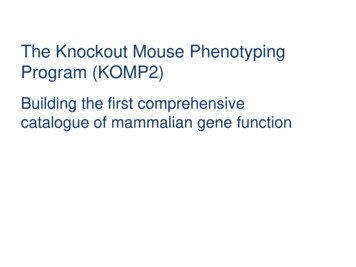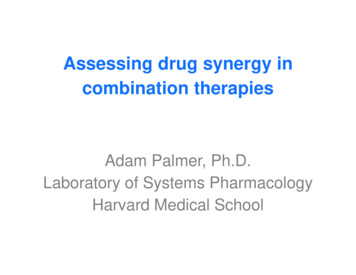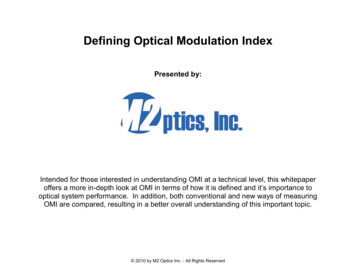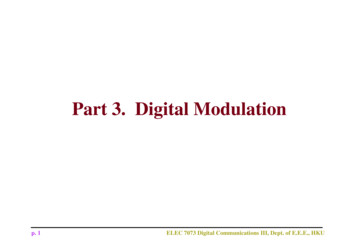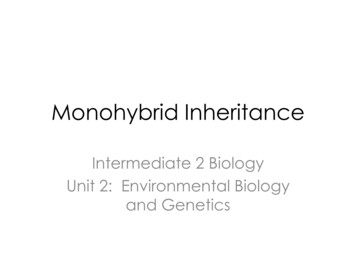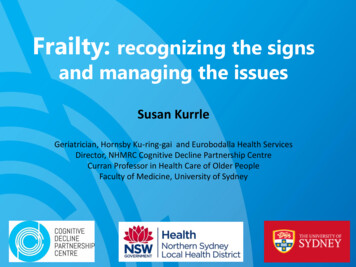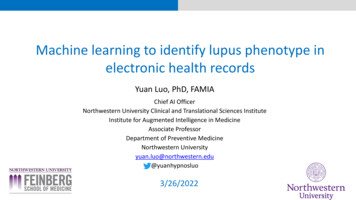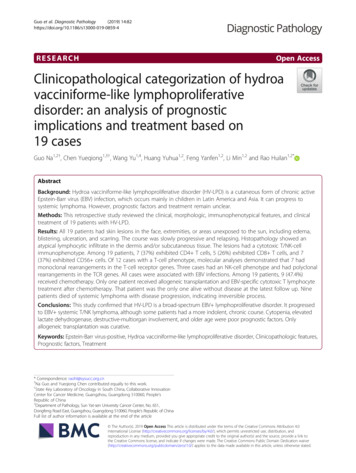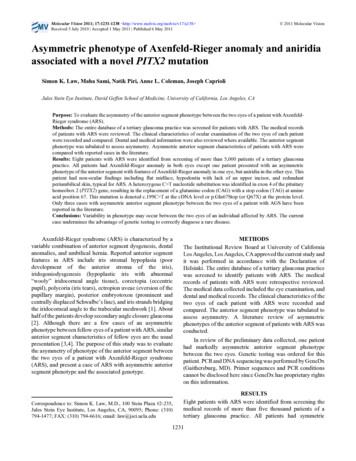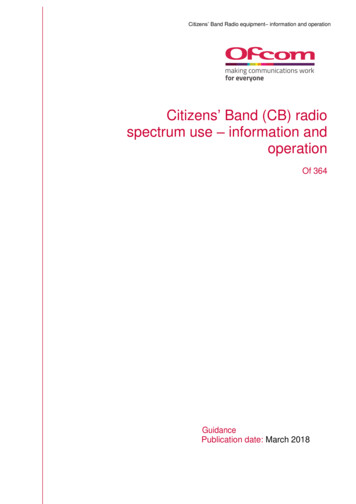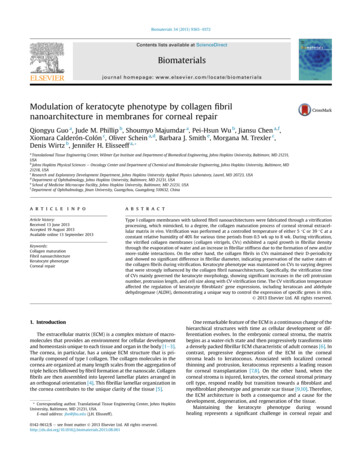
Transcription
Biomaterials 34 (2013) 9365e9372Contents lists available at ScienceDirectBiomaterialsjournal homepage: www.elsevier.com/locate/biomaterialsModulation of keratocyte phenotype by collagen fibrilnanoarchitecture in membranes for corneal repairQiongyu Guo a, Jude M. Phillip b, Shoumyo Majumdar a, Pei-Hsun Wu b, Jiansu Chen a, f,Xiomara Calderón-Colón c, Oliver Schein a, d, Barbara J. Smith e, Morgana M. Trexler c,Denis Wirtz b, Jennifer H. Elisseeff a, *aTranslational Tissue Engineering Center, Wilmer Eye Institute and Department of Biomedical Engineering, Johns Hopkins University, Baltimore, MD 21231,USAbJohns Hopkins Physical Sciences e Oncology Center and Department of Chemical and Biomolecular Engineering, Johns Hopkins University, Baltimore, MD21218, USAcResearch and Exploratory Development Department, Johns Hopkins University Applied Physics Laboratory, Laurel, MD 20723, USAdDepartment of Ophthalmology, Johns Hopkins University, Baltimore, MD 21231, USAeSchool of Medicine Microscope Facility, Johns Hopkins University, Baltimore, MD 21231, USAfDepartment of Ophthalmology, Jinan University, Guangzhou, Guangdong 510632, Chinaa r t i c l e i n f oa b s t r a c tArticle history:Received 13 June 2013Accepted 19 August 2013Available online 13 September 2013Type I collagen membranes with tailored fibril nanoarchitectures were fabricated through a vitrificationprocessing, which mimicked, to a degree, the collagen maturation process of corneal stromal extracellular matrix in vivo. Vitrification was performed at a controlled temperature of either 5 ! C or 39 ! C at aconstant relative humidity of 40% for various time periods from 0.5 wk up to 8 wk. During vitrification,the vitrified collagen membranes (collagen vitrigels, CVs) exhibited a rapid growth in fibrillar densitythrough the evaporation of water and an increase in fibrillar stiffness due to the formation of new and/ormore-stable interactions. On the other hand, the collagen fibrils in CVs maintained their D-periodicityand showed no significant difference in fibrillar diameter, indicating preservation of the native states ofthe collagen fibrils during vitrification. Keratocyte phenotype was maintained on CVs to varying degreesthat were strongly influenced by the collagen fibril nanoarchitectures. Specifically, the vitrification timeof CVs mainly governed the keratocyte morphology, showing significant increases in the cell protrusionnumber, protrusion length, and cell size along with CV vitrification time. The CV vitrification temperatureaffected the regulation of keratocyte fibroblasts’ gene expressions, including keratocan and aldehydedehydrogenase (ALDH), demonstrating a unique way to control the expression of specific genes in vitro.! 2013 Elsevier Ltd. All rights reserved.Keywords:Collagen maturationFibril nanoarchitectureKeratocyte phenotypeCorneal repair1. IntroductionThe extracellular matrix (ECM) is a complex mixture of macromolecules that provides an environment for cellular developmentand homeostasis unique to each tissue and organ in the body [1e3].The cornea, in particular, has a unique ECM structure that is primarily composed of type I collagen. The collagen molecules in thecornea are organized at many length scales from the aggregation oftriple helices followed by fibril formation at the nanoscale. Collagenfibrils are then assembled into layered lamellar plates arranged inan orthogonal orientation [4]. This fibrillar lamellar organization inthe cornea contributes to the unique clarity of the tissue [5].* Corresponding author. Translational Tissue Engineering Center, Johns HopkinsUniversity, Baltimore, MD 21231, USA.E-mail address: jhe@jhu.edu (J.H. Elisseeff).0142-9612/ e see front matter ! 2013 Elsevier Ltd. All rights 2013.08.061One remarkable feature of the ECM is a continuous change of thehierarchical structures with time as cellular development or differentiation evolves. In the embryonic corneal stroma, the matrixbegins as a water-rich state and then progressively transforms intoa densely packed fibrillar ECM characteristic of adult corneas [6]. Incontrast, progressive degeneration of the ECM in the cornealstroma leads to keratoconus. Associated with localized cornealthinning and protrusion, keratoconus represents a leading reasonfor corneal transplantation [7,8]. On the other hand, when thecorneal stroma is injured, keratocytes, the corneal stromal primarycell type, respond readily but transition towards a fibroblast andmyofibroblast phenotype and generate scar tissue [9,10]. Therefore,the ECM architecture is both a consequence and a cause for thedevelopment, degeneration, and regeneration of the tissue.Maintaining the keratocyte phenotype during woundhealing represents a significant challenge in corneal repair and
9366Q. Guo et al. / Biomaterials 34 (2013) 9365e9372regeneration [11,12]. Type I collagen is a natural choice employedfrequently as an engineered ECM substitute for corneal repair [13].However, conventional collagen gels are composed of loose networks of type I collagen fibrils with little organization, which ishardly comparable to the collagen structure in cornea. Compressionof conventional collagen gels has been employed to increasecollagen density and stiffness by applying a load onto the gel [14].These plastically compressed collagen matrices improved cellexpansion and stratification of corneal limbal epithelial cells, butstill showed limited success in maintaining the cellular phenotype[15,16]. In contrast, amniotic membrane (AM), a naturally derivedECM product used clinically to aid in corneal re-epithelialization,was able to preserve the characteristic morphology and keratocanexpression of keratocytes [17]. However, amniotic membrane lacksstandardization in its sources and processing method [15].Recently, we used vitrified collagen biomaterials (collagen vitrigel, CV) developed by Takezawa et al. [18] to culture various celltypes found in the cornea with the ultimate goal of developingcorneal substitutes [19,20]. CVs are synthesized from type Icollagen, and could be standardized with straightforwardmanufacturing and handling procedures. During vitrification,collagen gels are exposed to a specific temperature and humiditythat cause controlled evaporation of the water and organization ofcollagen fibrils. This vitrification process mimics, to some degree,the collagen maturation that occurs during the developmentalformation of the corneal stromal ECM [6,21]. More recently, wecompleted a design-of-experiments to evaluate the effects of time,temperature and humidity variables on collagen fibril structure,optical, mechanical, and thermal properties of CVs [22]. Ultimately,a variety of fibrillar structures were obtained that had a significantimpact on strength and transparency. However, the effects ofcollagen nanoarchitectures created through vitrification processingon keratocyte responses remain unknown.The purpose of this study was to evaluate the biologicalresponse of keratocytes to CVs with varying fibrillar content andorganization. We hypothesize that CVs with controlled fibrillarcollagen may provide an optimal environment for maintaining thekeratocyte phenotype. CV properties were manipulated by usingdifferent temperatures and processing times during vitrification.Keratocyte response was characterized by cell morphology andgene expression under either serum-free or serum-based cultures.Typically, in previous studies, keratocyte phenotype was analyzedqualitatively [11]. Here, we quantitatively examined keratocytemorphology in terms of cell size, protrusion number, and protrusion length, using a custom-designed program written in MATLAB(MathWorks", Natick, MA) [23e25]. We also evaluated the effect ofthe CVs’ collagen nanoarchitectures on various keratocyte geneexpressions, including the expressions of keratocan, aldehyde dehydrogenase (ALDH), and biglycan.2. Materials and methods2.1. Preparation of collagen membranesCollagen membranes were prepared in a three-step procedure, as previouslydescribed [19]. First, conventional collagen gel was formed by mixing equal volumes of 0.5% type-I collagen solution (native collagen from bovine dermis,pH ¼ 3.0, AteloCell", Cosmo Bio Co., Ltd., Tokyo, Japan) and culture medium containing Dulbecco’s Modified Eagle’s Medium (DMEM), 10% fetal bovine serum (FBS),20 mM hydroxyethyl piperazineethanesulfonic acid (HEPES), 100 units/mL penicillin, and 100 mg/mL streptomycin. The mixed solution of 2.0 mL was quicklypoured into one well of a 6-well plate, and then incubated at 37 ! C for 2 h tocomplete the gelation of the collagen. Second, the collagen gel was asepticallyvitrified by drying under a controlled temperature and relative humidity for aprescribed time period from half week up to 8 weeks. The relative humidity of 40%was used unless otherwise specified. The collagen gel was first vitrified over 3 daysand then rinsed thoroughly with PBS buffer three times for 10 min each tocompletely remove the serum-based culture medium. The collagen gel was furthervitrified until a predetermined time was achieved, leading to the formation of arigid glasslike collagen membrane. Third, the collagen membrane was thoroughlyrehydrated with PBS buffer before use. The thicknesses of CVs right before and afterrehydration were calculated from measuring the weight and assuming a constantdensity of 1 g/mL.2.2. Transmission electron microscopy (TEM)The nanostructure of collagen membranes was examined by TEM. Samples werefixed in 3% paraformaldehyde, 1.5% glutaraldehyde, 5 mM MgCl2, 5 mM CaCl2, 2.5%sucrose, and 0.1% tannic acid in 0.1 M sodium cacodylate buffer at pH 7.2 overnight at4 ! C. After buffer rinse, samples were post-fixed on ice in the dark in 1% osmiumtetroxide for 1 h. Following a DH2O rinse, plates were stained with 2% aqueousuranyl acetate (0.22 mm filtered, 1 h, dark) and dehydrated in a graded series ofethanol before being embedded in Eponate 12# resin (Ted Pella, Inc., Redding, CA).Plates were polymerized for two to three days at 37 ! C before transferring them to60 ! C overnight. Thin sections, 60e90 nm, were cut with a diamond knife on theReichert-Jung Ultracut E ultramicrotome and then placed on naked copper grids.Grids were stained with 2% uranyl acetate in 50% methanol. They were imaged witha Hitachi 7600 TEM at 80 kV. Images were captured with an AMT CCD (1k # 1k)camera (Advanced Microscopy Techniques, Woburn, MA). TEM images of bothtransverse and coronal planes in the CV central portions were obtained. ImageJ (NIH,Bethesda, MD) were used to analyze the collagen fibril organization in CVs, includingthe fibril diameter, fibril density, and D-periodicity of collagen banding. Specifically,both fibril diameter and D-periodicity of collagen banding were evaluated from w50collagen fibrils in the transverse plane view of the TEM images. The fibril density wasobtained based on the measurements of four different locations in the coronal planeview of the TEM images.2.3. Keratocytes isolation and cultureFull-thickness corneas were harvested from bovine eyes within 36 h afterslaughter. Keratocytes were isolated using a sequential collagenase (Type 2,Worthington Biochemical Corp., Lakewood, NJ) digestion. Specifically, bovinecorneas were collected and cut into small pieces with a scalpel and then transferred to a 50-mL centrifuge tube containing 3 mg/mL collagenase in DMEM/F-12.The corneal pieces were incubated on a rotary shaker at 240 rpm at 37 ! C for60 min and then collected using a 70 mm cell strainer (BD Falcon, BD Biosciences,San Jose, CA). The partially digested corneas were transferred to a fresh collagenase solution for a second digestion for 60 min. This process was repeated for athird digestion for 120 min, and the digested cells from the third digestion werecollected and centrifuged at 1400 rpm for 10 min. The cell pellet was resuspendedand cultured on general tissue culture plates (TCP) or CV-covered plates at 37 ! Cand 5% CO2. Either serum-free or serum-based culture medium was used. Theserum-free medium consisted of DMEM/F-12, 1% of 10 U/mL penicillinestreptomycin, and 0.5% of 1.25 mg/mL amphotericin B (Life Technologies, Carlsbad, CA).The serum-based medium contained DMEM/F-12, 10% FBS, 1% of 10 U/mL penicillinestreptomycin, and 0.5% of 1.25 mg/mL amphotericin B. The cells wereplated at a concentration of 5000 cells/cm2 using the serum-free medium, whileat a concentration of 1000 cells/cm2 using the serum-based medium. Before imaging and gene expression analyses, keratocytes were cultured over 3 wk inserum-free medium or 6 d in serum-based medium. Keratocyte morphologieswere examined by staining with the LIVE/DEAD" Viability/Cytotoxicity Kit (LifeTechnologies).2.4. AlamarBlue" assayProliferation of keratocytes was measured by AlamarBlue" Assay (Invitrogen,Frederick, MD). This assay employs a fluorometric/colorimetric growth indicatorthat changes from an oxidized (non-fluorescent, blue) form to a reduced (fluorescent, red) form when reduced by mitochondrial respiration of the cells. In thisassay, the percent reduction of alamarBlue, which is determined by the ratio of theconcentration of the reduced form to the total concentration of alamarBlue, isproportional to the amount of cells. Primary keratocytes were plated in 24-wellplates at a concentration of 5000 cells/cm2 using the serum-free medium, or1000 cells/cm2 using the serum-based medium. At predetermined time points, themedium was refreshed and cells were incubated with 10% alamarBlue at 37 ! C and5% CO2 for 4 h. A sample of 200 mL of alamarBlue solution was then transferred intoa 96-well plate for fluorescence reading. The absorbance was monitored at 570 nmand 600 nm using a fluorescence plate reader (Synergy 2, Biotek, Seattle, WA). Theproliferation of keratocytes was determined by the increase of alamarBlue reduction at Day 4 relative to Day 2. This assay was performed in four independentexperiments.2.5. Quantification of cellular morphologyImage processing for quantification of the cellular morphological features fromfluorescent images was carried out using a custom-designed program developed inMATLAB [24,25]. In brief, we first segmented individual cells in images and
Q. Guo et al. / Biomaterials 34 (2013) 9365e9372measured the cell spreading area. For the quantification of protrusion morphology,we first determined the morphological skeleton of individual cell contours andidentified the main body region of cells [26]. The protrusions were identified as theskeleton structures that were extended beyond the main body region. The protrusions were further classified into two subtypes: 1st order protrusions and 2ndorder protrusions. The 1st order protrusions were considered to be the protrusionsstemming directly from the cell body, and 2nd order protrusions were the onesbranching from other protrusions. The length of each protrusion was measured andthe total number of protrusions for individual cells was determined as the summation of 1st order and 2nd order protrusions. The morphology of keratocytes,including cell size, total number of protrusions, mean length of protrusions, primaryprotrusion number, secondary protrusion number, and the ratio of secondary toprimary protrusions, was evaluated based on the measurements of w60 cells.2.6. Gene expression analysisTotal RNA was isolated from cultured keratocytes using TRIzol reagent (LifeTechnologies) and reverse transcribed into cDNA using SuperScript II First StrandSynthesis Kit (Life Technologies). cDNA was used for real-time PCR reactions using aStepOnePlus Real-Time PCR System (Applied Biosystems", Life Technologies). ThePCR primer sequences are listed in Table 1. GAPDH was used as a reference gene. Therelative gene expression was determined using the 2eDDC(T) method [27].2.7. StatisticsData were represented as averages standard deviations, unless otherwisespecified. Two-tailed unpaired t-tests were performed to determine significanceusing Graphpad Prism (Graphpad Software Version 5, Graphpad Software, Inc., LaJolla, CA). p value of 0.05 was considered statistically significant.3. Results3.1. Collagen vitrigel preparation and nanoarchitectureCVs were prepared following a three-stage sequence: gelation,vitrification, and rehydration (Fig. 1A) [19,22]. When the collagensolution containing 2.5 mg/mL type I collagen was first gelled at37 ! C for 2 h, it produced a collagen gel with a thickness of 2.0 mm.This collagen gel was translucent and soft. During vitrification, thecollagen gel was dried slowly at a controlled temperature of either5 ! C or 39 ! C under a relative humidity of 40%. This resulted in CVformation with a dramatically decreased thickness. After vitrification at 5 ! C for 2 wk, the vitrified gel had a thickness of 9 1 mm,which is a 220-fold decrease in the thickness of the membrane. Tocompare, the CV vitrified at 39 ! C for 2 wk exhibited a smallerthickness of 6 1 mm, which is a 330-fold decrease in the thickness.After rehydration, the CV still maintained its shape and swelled inPBS buffer to form a hydrated membrane with a thickness ofapproximately 50 mm.CVs reconstructed from highly hydrated collagen gels showeda distinctive nanoarchitecture. Fiber morphology depended onthe CV conditions as visualized through TEM images in themiddle portions. A three-dimensional view of a CV (5 ! C, 2 wk) isTable 1RT-PCR Primer ence (50 -30 )Annealing temp (! CTGCACCTGGTCATAAGTCCCTCCACGA9367shown in Fig. 1B. Unlike conventional collagen gel showing homogeneous distribution of the collagen fibrils, this CV demonstrated a random fibrillar organization in the transverse plane,but showed a layer-by-layer lamellar structure in the coronal andsagittal planes. Similar results were also observed in all the otherCVs, even for the CV 5 ! C, 0.5 wk that was vitrified for a short timeperiod (Fig. 2AeH).The organization of the collagen fibrils was strongly affected bythe vitrification processing conditions, including the temperatureand the vitrification time. First, no significant difference in collagenfibrillar diameter was observed in despite of varying vitrificationtemperature and vitrification time (Fig. 2I). Second, all of thesamples clearly showed the characteristic collagen banding withspacing around 60 nm (Fig. 2J). No significant difference in Dperiodicity was observed at different temperatures and vitrificationtimes. Third, at a constant temperature, the collagen fibril densitydramatically increased along with the vitrification time (Fig. 2K).The fibril density of the CV at 5 ! C for 0.5 wk is as low as 5 fibers/mm2. After vitrification at 5 ! C for 2 wk, the fibril density wasdramatically increased to 95 fibers/mm2. For the CVs prepared at39 ! C, the fibril density was very high and close to the maximumdensity of the fiber in the collagen matrix, which was estimated tobe 180 fibers/mm2 based on an assumption of hexagonally arrangedcollagen fibrils without fibrilefibril spacing for a CV with fibrildiameter of 80 nm. Therefore, the collagen fibril density increasedwith vitrification temperature, which is consistent with thedecreased membrane thickness as we observed above. Furthermore, collagen fibrils with large bending curvature decreased in theCVs prepared at a higher temperature and/or longer vitrificationtime when comparing the CVs vitrified for 2 wk at 5 ! C vs. 39 ! C,vitrified at 5 ! C for 0.5 wk vs. 2 wk, and vitrified at 39 ! C for 1 wk vs.2 wk (Fig. 2AeD).3.2. Morphology and proliferation of subcultured keratocytesThe CV nanoarchitecture modulated keratocyte morphologicalresponse. Typical morphologies of keratocytes cultured on theseCVs are shown in Fig. 3AeH. Characteristic stellar phenotype ofcultured keratocytes was observed using serum-free medium(Fig. 3AeD). Compared to the TCP control, the keratocytes culturedon CVs had more and longer protrusions, as well as more intercellular connections. The number and length of keratocyte protrusionsincreased on the CVs processed for longer vitrification times.Moreover, more pinning points were observed in the extendedprotrusions of the keratocytes cultured on the CV processed for alonger time, especially on the CV 39 ! C, 8 wk (Fig. 3AeD).Keratocyte morphology under serum-free culture was analyzedquantitatively with a custom-designed program written in MATLAB[24,25]. Fig. 4AeC illustrates an example of a keratocyte cultured onCV 39 ! C, 8 wk. Individual cellular contours were first obtainedidentification of the cell body and protrusions (Fig. 4B). The cell sizewas determined as the area within the cellular contour, includingcell body and protrusions. Based on the cellular contour, themorphological skeleton was determined and the protrusions wereclassified into two subtypes depending on their starting position.Primary protrusions, or 1st order protrusions, were defined as thelongest protrusions stemming directly from the cell body, whilesecondary protrusions, or 2nd order protrusions, were thosebranching from the primary protrusions.Keratocyte morphologies were carefully quantified, includingcell size, total number of protrusions, mean length of protrusions,number of primary protrusions, number of secondary protrusions,and the ratio of secondary to primary protrusions. The cell sizes ofkeratocytes cultured on CVs were significantly higher than thosecultured on TCP (Fig. 4D), which is related to the increased number
9368Q. Guo et al. / Biomaterials 34 (2013) 9365e9372Fig. 1. Collagen vitrigel preparation and alignment: (A) three-step procedures, and (B) TEM image of CV central portions showing 2D alignment of matured collagen fibrils byvitrification.Fig. 2. TEM images of CVs and collagen fibril analysis: (AeD) Transverse plane, (EeH) coronal plane, and (IeK) collagen fibril analyses. Four CVs were used: (A, E) CV 5 ! C, 0.5 wk, (B,F) CV 5 ! C, 2 wk, (C, G) CV 39 ! C, 1 wk, and (D, H) CV 39 ! C, 2 wk. Collagen fibril analyses include (I) fibril diameter, (J) d-periodicity (banding), (K) fibril density. The TEM sampleswere obtained from the center portions of the collagen membranes. Collagen fibrils with large bending curvature were indicated by triangle. The error bars in (I, J) represent thestandard deviation of the mean. Scale bar in (AeH): 200 nm. ***p 0.001.
Q. Guo et al. / Biomaterials 34 (2013) 9365e93729369Fig. 3. Keratocyte morphologies cultured on CVs using two different culture media: (AeD) serum-free culture medium, and (EeH) culture medium with 10% FBS. Four cell culturesubstrate conditions were used: (A, E) TCP control (B, F) CV 39 ! C, 1 wk, (C, G) CV 39 ! C, 2 wk, and (D, H) CV 39 ! C, 8 wk. Pinning points in cell extensions were highlighted bytriangle. Scale bar: 200 mm.and length of protrusions (Fig. 4EeF). Fig. 4E shows that thenumber of protrusions per each keratocyte increased with thevitrification time of the CVs. Keratocytes cultured on CV 39 ! C, 8 wkexhibited on average 27 protrusions per cell, a 70% increase overthe average number of protrusions of those cells cultured on TCP. Asimilar, but smaller trend was also observed in the mean length ofkeratocyte protrusions. Interestingly, no significant difference wasobserved in the primary, or 1st order, protrusion number of thekeratocytes cultured on TCP and CVs (Fig. 4G). In contrast, theaverage number of secondary, or 2nd order, protrusions of thekeratocytes increased markedly from 7 protrusions in TCP, to 12protrusions in CV (39 ! C, 1 wk), to 14 protrusions in CV (39 ! C,2 wk), and to 18 protrusions in CV (39 ! C, 8 wk) (Fig. 4H). A similartrend to the secondary protrusion number was also observed in theratio of secondary to primary protrusions, further demonstratingthat extent of branching/number of secondary protrusions perprimary protrusion increased as a function of vitrification time(Fig. 4I).The cellular proliferation rate, determined by alamarblue,changed depending on the CV structure/morphology (Fig. 5). Underserum-free culture and compared to the TCP control, a significantincrease in the keratocyte population was indicated on the threeCVs with highly condensed collagen fibrils, including CV (5 ! C,2 wk), CV (39 ! C, 1 wk), and CV (39 ! C, 2 wk). Moreover, whencomparing CV (5 ! C, 1 wk) vs CV (5 ! C, 2 wk), and CV (39 ! C, 1 wk)vs. CV (39 ! C, 2 wk), it is evident that the cells tended to proliferatemore on the CVs that had a longer vitrification time. Under serumbased culture, the keratocytes exhibit a fibroblastic phenotype(Fig. 3EeH). No significant differences in the cellular morphology orproliferation were observed in any of CVs. Nevertheless, thesekeratocyte fibroblasts maintained their phenotypic markers tovarying degrees based on the collagen nanoarchitectures of CVs.3.3. Keratocyte gene expression dependence on collagennanoarchitectureKeratocyte gene expression, including keratocan, ALDH, andbiglycan, was tested using CVs with different nanoarchitectures.Under serum-based culture, keratocytes lost characteristics of theirnative phenotype in TCP. Compared to TCP, the gene expression ofbiglycan was reduced significantly using all four types of CVs(Fig. 6). For CVs prepared at 5 ! C, the expression of keratocan wasslightly lower using the CV processed for half week than in TCP, butmarkedly increased when using the CV processed for a longerperiod of two weeks. The expressions of ALDH in cells cultured onboth CVs vitrified at 5 ! C were dramatically increased compared toin those cultured on TCP. For CVs prepared at 39 ! C, the expressionof ALDH was slightly lower when employing CV vitrified for oneweek than that on TCP, but markedly increased when using CVvitrified for a longer period of two weeks. The expressions of keratocan in cells using both CVs prepared at 39 ! C were greatly raisedcompared to those using TCP.4. DiscussionVitrification provides a convenient means to manipulate thenanoarchitecture of collagen membranes. Lamellar structures wereformed in these vitrified collagen membranes. During vitrification,collagen fibril density was dramatically increased, which led to adecrease of fibril-to-fibril distance and contributed to the enhancedtransparency and mechanical properties reported previously [22].In addition, fewer collagen fibrils with large bending curvaturewere observed in the CVs prepared under longer vitrification times,indicating that the collagen fibrils became stiffer during vitrification. This may be explained by new and/or more stable interactionsformed in the collagen fibrils through the vitrification process,which is consistent with our previous results showing increasedthermal stability of CVs with vitrification time [22,28]. No significant difference was observed in the collagen fibril dimension andperiodic banding distance. The maintenance of collagen bandingperiodicity suggests that the CVs were not denatured during thevitrification process, even under the high temperature of 39 ! C thatis above the normal human body temperature range. This isbecause the denaturing temperatures of these CVs we observedpreviously were between 54 and 59 ! C, much higher than the CVprocessing temperature [22]. The processing of collagen membranes by vitrification likely resembled, to some extent, thecollagen maturation in embryonic corneal stromal developmentbecause condensed collagen lamellae composed of collagen fibrilswere formed with new and stable interactions [6].The flexibility in collagen ultrastructure of CVs provided avehicle to investigate the effect of nanofibrillar matrix on cellularresponses. In this study, the organized collagen membranes supported the growth of keratocytes in serum-free medium when cellsgenerally do not proliferate. On the other hand, cells proliferatingunder serum-based culture on the CVs were able to maintain akeratocyte phenotype instead of dedifferentiating into fibroblasts.CVs prepared using longer vitrification times were preferable, asthey offered an extracellular environment that more closelymimicked the natural corneal stroma. Human corneal stroma has
9370Q. Guo et al. / Biomaterials 34 (2013) 9365e9372Fig. 4. Morphological analysis of keratocytes cultured on CV vitrified at 39 ! C using serum-free medium. (AeC) A keratocyte example cultured on CV (39 ! C, 8 wk) (A) with cellularcontour identified in (B) and morphological skeleton acquired in (C). Based on cellular contour and skeleton, the dependence of keratocyte morphologies on CV vitrificationprocessing time was examined (DeI), including cell size (D), total number of protrusions (E), mean length of protrusions (F), primary protrusion number (G), secondary protrusionnumber (H), and the ratio of secondary to primary protrusions (I). The error bars in (DeI) represent the standard deviation of the mean. Keratocytes cultured on the TCP were testedas a control. All statistical differences against the TCP control are indicated. *p 0.05, **p 0.01, ***p 0.001.been reported to consist of collagen fibrils with a diameter of 36 nmat a high density of about 700 fibers/mm2 [29]. In our study, thehighest collagen fibril density in the four CVs studied almostreached a maximum of 180 fibers/mm2, assuming no fibrilefibrilspacing. Our fibril diameter, at about 80 nm or above (Fig. 2), wasmore than twice that in naturally occurring corneal stroma. Thus,creating a further increase in collagen fibril density will requiresignificantly reducing the collagen fibril diameter. Collagen fibrilcondensation could also be achieved by plastic compression ofconventional collagen gels, but to an even lesser degree ascompared to vitrification [14].Quantitative analysis of the effect of collagen nanoarchitectureon keratocyte phenotype is a potentially powerful method tocorrelate cell morphology and gene expression/phenotype. Nosystematic studies have been reported in which the effect ofdifferent extracellular environments on the keratocyte ph
umes of 0.5% type-I collagen solution (native collagen from bovine dermis, pH ¼ 3.0, AteloCell", Cosmo Bio Co., Ltd., Tokyo, Japan) and culture medium con-taining Dulbecco's Modified Eagle's Medium (DMEM),10% fetal bovine serum (FBS), 20 mM hydroxyethyl piperazineethanesulfonic acid (HEPES), 100 units/mL peni-cillin, and 100 mg/mL .
